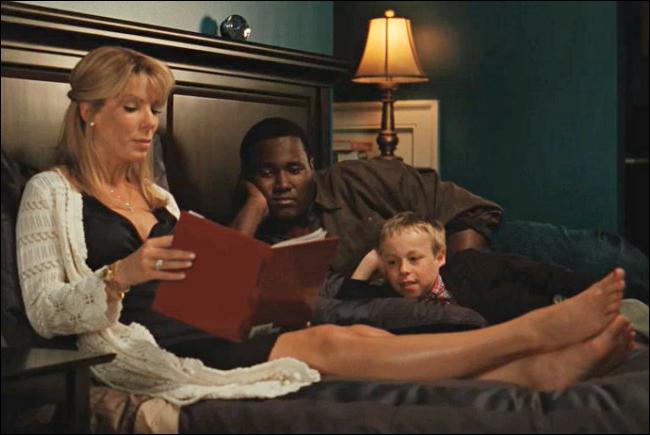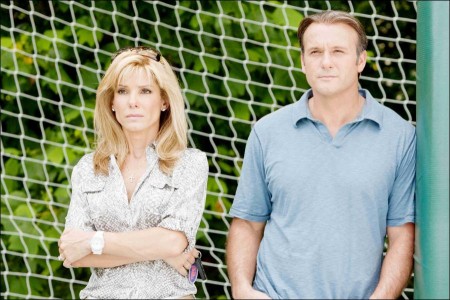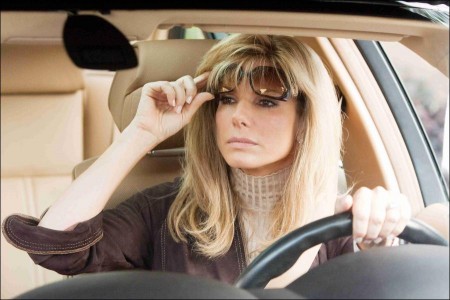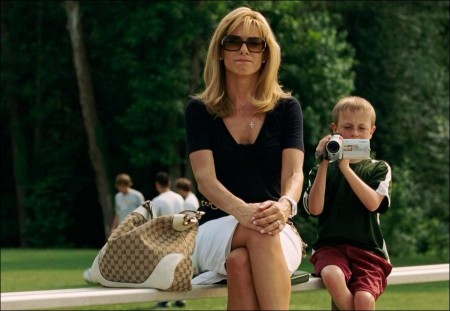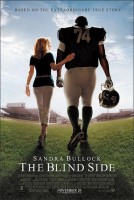Teenager Michael Oher (Quinton Aaron) is surviving on his own, virtually homeless, when he is spotted on the street by Leigh Anne Tuohy (Sandra Bullock). Learning that the young man is one of her daughter’s classmates, Leigh Anne insists that Michael—wearing shorts and a t-shirt in the dead of winter—come out of the cold. Without a moment’s hesitation, she invites him to stay at the Tuohy home for the night. What starts out as a gesture of kindness turns into something more as Michael becomes part of the Tuohy family despite the differences in their backgrounds.
Living in his new environment, the teen faces a completely different set of challenges to overcome. And as the family helps Michael fulfill his potential, both on and off the football field, Michael’s presence in the Tuohys’ lives leads them to some insightful self-discoveries of their own.
The ideal left tackle is big… He is wide in the butt and massive in the thighs. He has long arms, giant hands, and feet as quick as a hiccup. This is a rare and expensive combination, the need for which can be traced to that Monday night game and Lawrence Taylor. For on that day, he not only altered Joe Theismann’s life but mine as well. Leigh Anne Tuohy in “The Blind Side”
Family and football were two things Michael Oher had never experienced in his life. But they ultimately became the two things that changed his life forever. Growing up virtually abandoned in the poverty-stricken projects of Memphis— appropriately called Hurt Village—Michael had had few options and even fewer opportunities. But that was before he crossed paths with an unstoppable force in the person of Leigh Anne Tuohy. What followed was a series of events that would be hard to believe…except for the fact that the events are true. Michael became a member of the Tuohy family, who nurtured his abilities both on and off the football field, resulting in an inspiring story that is still unfolding today.
Director/screenwriter John Lee Hancock states, “It really is two different stories, one of which is more of a question: Who is Michael Oher and why did the stars align to shine so brightly on this kid from the projects in Memphis? And then on the other side, it’s a great story about how this unique family evolved, and the unconventional motherson relationship at its center. Sports, specifically football, was the engine that propelled the story forward, but he could have been a dancer or a pianist—it wouldn’t have made any difference. The journey that Michael and the Tuohy family go on is the heart of the movie.”
Sandra Bullock, who stars in the role of Leigh Anne Tuohy, notes, “The beauty of the story is that you think it’s one thing and it turns out to be something else, and those are usually the best things in life. I thought the script was going to be about football until I read it and realized that it’s really about family.”
She adds that, while it is obvious how much the Tuohys did for Michael Oher, “it was not that one-sided. They certainly did a good deed in taking in this young man in such a loving and generous way. But, in turn, he brought out a side of their family that they didn’t even realize was missing. The family seemed to have all the success and joy in the world, but when Michael showed up, it was as if he was the final piece to the puzzle.”
The actress’s observation is confirmed by her real-life counterpart, Leigh Anne Tuohy, who offers, “I think Michael had a much greater impact on our lives than we did on his. You take so much in life for granted, but when Michael moved in with us, he made us realize how blessed we are. We viewed life differently after he joined our family.”
How Michael Oher became a part of the Tuohy family was first chronicled in the best-selling book The Blind Side: Evolution of a Game, written by Michael Lewis, who had previously focused on the sport of baseball in his bestseller Moneyball. The author reveals that he stumbled on the story of Oher and the Tuohys almost by accident. “For anyone who wants to interpret the whole thing as some kind of miracle, there’s a lot of evidence,” he laughs.
Lewis, who had gone to high school with Leigh Anne’s husband, Sean Tuohy, had initially contacted his old classmate to interview him for an article about their school baseball coach. That eventually led to his meeting Michael and learning of his relationship with the Tuohys.
The book The Blind Side juxtaposes Michael’s story with an in-depth look at how the position of left tackle on a football team has grown in importance, instigated by a single, unforgettable play—Lawrence Taylor’s career-ending sack of quarterback Joe Theismann in November 1985. Assigned to protect a right-handed quarterback from what he can’t see coming, a good left tackle often earns a salary second only to the quarterback himself. Michael Lewis admits, “At first I thought that was bizarre because almost nobody pays attention to the left tackle. But when I looked into it, I learned that the market had determined this incredible value in the position and that he’d evolved into a particular physical type—the elephant as ballerina, for lack of a better description. That interested me. Then when Sean told me that Michael was being scouted as a prospect for the position of left tackle, I could see how it all went together.”
Tim McGraw, who stars as Sean Tuohy, asserts that you don’t have to be a sports fan to appreciate “The Blind Side.” “Whether or not you are interested in football, or sports at all, the story behind this movie is so heartwarming, I think it will appeal to everyone.”
Producer Broderick Johnson agrees. “The appeal of this story is the combination of heart and humor, as well as sports, which has had its share of negative press in recent years. In fact, so much of the general news these days is about all the things that are going wrong and this is one of those instances where something very positive happened that transformed both Michael Oher and the Tuohy family. It’s an inspiring story in a world that’s divided, in large part, by the ‘haves’ and the ‘have-nots.’ It shows that you can be a good Samaritan and it can benefit you as much as the person you’re helping. I think it’s very entertaining, but it’s also very powerful.”
One of the things that set “The Blind Side” apart was that when the book was published, and even as the movie was being made, much of Michael’s story was still unfolding. Producer Andrew A. Kosove explains, “It is a current events story, as it were, but I don’t think that creates complications as much as it creates opportunities. It’s very timely, especially in the 21st century, when we have come to understand that there is no set type of family. We live in a society made up of different kinds of families, where the only things that really matter are our love and support for one another. I think that’s a wonderful thing, and it’s a message that people can really relate to in this day and age.”
The fact that the “The Blind Side” takes place in the present day also benefited Hancock, who says, “I loved the book and spoke at length with Michael Lewis, who is a fantastic writer, but, if possible, it’s always important to meet the real people and hear how they talk instead of just reading it. So spending time with the Tuohys and Michael and being around them as a family was invaluable.”
For the Tuohy family, seeing this chapter of their lives become a best-selling book and then a major motion picture was somewhat bemusing. Sean Tuohy relates, “When Michael Lewis first called, he was going to write a nice, little article. We still haven’t quite figured out how, somewhere along the way in this whole thing, it went from a nice little article to a book and now a movie,” he laughs.
“The Tuohys opened up their home and their lives, so we felt a great deal of responsibility to do right by their family, and that’s a lot to live up to,” says Bullock. “You want people to be entertained, but you also want them to leave the theatre with a genuine understanding of who these people are. I know that was important to John, who was determined that we not do anything that didn’t ring true. It was one of the things I really liked about working with him; he’s a wonderful filmmaker.”
Kosove adds, “John Lee Hancock and Alcon have a relationship that goes back more than ten years. He is a fantastic writer and an outstanding director. We knew he would hit this movie out of the park—or should I say into the end zone—which is exactly what he did.”
Producer Gil Netter comments that everyone involved in the film, on both sides of the camera, “shared a common goal, no pun intended. The entire cast and crew wanted to do justice to this extraordinary story and the people behind it. It made the whole production a tremendously fulfilling experience, from beginning to end, and I am very proud of the movie.”
This team is your family and you have to protect them… Tony is your quarterback. You protect his blind side. When you look at him think of me. How you have my back.
Casting on the “The Blind Side” began with Sandra Bullock, who Kosove says was “the first and only choice for the role of Leigh Anne Tuohy.”
Bullock read the screenplay and recalls, “It was a beautifully written script. It had all the right beats in all the right places. And I was amazed how John gave every one of the characters such a nice arc…each character has a distinct journey.”
Nevertheless, it took some convincing on the part of Hancock to get the actress to accept the role of the headstrong wife and mother, who, with a simple act of kindness, brings Michael Oher in out of the cold, literally and figuratively.
Hancock remembers, “Sandy liked the script but was having trouble figuring out how to portray Leigh Anne. We would meet and she would ask all kinds of questions, but I wasn’t able to come up with the answers she was looking for.”
“That was my biggest reservation,” Bullock affirms. “John would try to explain her to me, but he’d always fall short. I kept feeling something is missing.”
Hancock continues, “I think Sandy was understandably frustrated with my inability to describe the character, but that’s because Leigh Anne is indescribable. It’s one of the wonderful things about her. Finally I said, ‘Sandy, you just have to meet her.’ So we went down to Memphis and I introduced her to Leigh Anne. It turned into a full day spent with Leigh Anne and everything that involves: craziness and mayhem and fun and laughter and getting a lot of stuff done in very short order. At the end of the day, Sandy turned to me and said, ‘Okay I get it.’ She had experienced firsthand the tornado that is ‘Tuohy time,’ and we were off and running.”
“Once I saw the whole package, I realized why John couldn’t explain her,” the actress states. “How can you explain that kind of energy? By the end of one day with Leigh Anne, I was exhausted. She manages to do what she wants to do in the manner she wants to do it. She doesn’t care what it takes; she just gets it done her way. All I can say is, if there were more Leigh Anne Tuohys, the world would be a better-run, more harmonious and more productive place…as long as it was by her rules,” she laughs. “It was terrifying to think of playing her, but it was a challenge I couldn’t say no to. She’s such an amazing person.”
Playing Leigh Anne went beyond imparting her singular spirit. Bullock also needed to change her familiar brunette hair to match her character’s blonde locks, and she worked with dialect coach Francie Brown to master Leigh Anne’s accent, as well as the cadence and inflections in her voice.
In order for Brown to be an effective coach, she needed to hear from the source. Leigh Anne Tuohy reveals, “She hounded me. She called me and said, ‘Say Leigh Anne 30 times. Say Sean.’ There were words she’d want me to go over and over, and I’m thinking, ‘Didn’t you get it the first dozen times?’ She was very persistent, but she did a good job,” she smiles.
Bullock, who is also from the South, notes, “Many people think a Southern accent is a Southern accent, but there are many different ones. But it wasn’t just Leigh Anne’s accent. My dialect coach explained it was also the intent behind her words. Once we figured out the intent on top of the dialect, it helped so much. I wasn’t trying to copy her exactly because then it becomes a caricature, but there is a way she goes about life that you need to pick up on or you’re going to be left behind. So we wanted to capture as much of the essence of Leigh Anne as we could.”
The strength of Leigh Anne Tuohy’s personality made casting the role of her husband, Sean Tuohy, in Hancock’s words “difficult.” The director goes on to explain, “When you’re around the Tuohy family, you get the sense that she’s the engine, but he is the glue that holds it all together. Sean is completely self-assured and comfortable in his own skin. He has that Southern ex-athlete attitude; there’s a swagger there.”
“We needed an actor who would have a real screen presence opposite the whirlwind that is Leigh Anne,” Johnson confirms. “We had to have an actor who would make Sean feel just as important as she without having as much screen time.”
Hancock says they found everything they were looking for in actor and country music superstar Tim McGraw. “When Tim McGraw’s name came up, I thought he would be a great choice. I had admired his work in movies and he had all the qualities we were looking for. It felt like a natural fit and he turned out to be fantastic. I loved working with him.”
In fact, McGraw fit the role even more naturally than the filmmakers initially thought. Both McGraw and the real Sean Tuohy had grown up in Louisiana, and, like Sean, the actor had also excelled in sports throughout his life. McGraw attests, “I was always an athlete; I can’t remember ever not playing sports. I thought that’s what I was going to do with my life…until I got to college and bought a guitar. And the rest,” he grins, “is history.”
The actor adds that the similarities between him and Sean Tuohy were only part of the reasons he was drawn to the role. “Sean is an all-around good guy, and the inspirational story of what he and his family did for this kid—the time, the effort and the love he put out—is pretty incredible. Also, a positive movie about sports is something I really enjoy seeing because sports, if played the right way and coached the right way, can really teach you a lot about yourself and about life in general.”
McGraw’s words are borne out in the story of the film’s central character. Finding the right actor to play the role of Michael Oher posed the filmmakers’ biggest casting challenge by far. He had to be the right age and have Michael’s preternatural size, but he also had to convey an innate reserve.
Hancock comments, “The process of casting Michael Oher was long and exhausting; it was a needle in a haystack situation. We carried out a nationwide search, going to a lot of different cities and hiring local casting directors to find actors with the qualifications we needed, both physically and spiritually, for lack of a better word. We were looking for a very specific combination. In short, we needed a gentle giant.”
They discovered the perfect combination of size and personality in an aspiring actor named Quinton Aaron, who was living in New York when he was called in to audition for “The Blind Side.” Two weeks later, he was being flown to Los Angeles to meet with Hancock and the producers.
“We looked at a lot of actors who didn’t quite fit the bill,” Hancock recalls. “When I saw Quinton’s tape, there was something about him that was missing in the other ones. Then when he came in the door, my first instinct was to hug him, and it was that quality that first struck me. He also has a face that draws you in; when he’s quiet and looks at you with those doe eyes, there’s a story there that you want to know. I just had a gut feeling he was our guy…that we were about to change his life in a spectacular way.”
Learning he had won the lead role of Michael Oher “was better than any dream,” says Aaron, who adds that he felt a strong connection to his onscreen alter ego. “When I read the story, I saw that we had a lot in common. Neither of us knew our fathers growing up. I was the biggest kid in my school; he was the biggest kid in his school. I kept to myself a lot and was more of a quiet, shy kid, and that’s pretty much what he was like. I also played some football at one point, but I wasn’t good at it.”
Hancock remarks, “I knew Quinton had played a little high school football, but the concern was that he had to look like he could really handle himself on a football field. We got him involved with trainers, who set him up with a regimen of diet and workouts. He lost a lot of weight, but, more importantly, he started looking like an athlete.”
Aaron, who lost more than 100 pounds in preparation for the role, relates, “I was determined to do anything and everything required, because if you love what you’re doing, you are going to give one hundred and ten percent. Before the movie started I went through seven weeks of intense training, with two-a-day practices every day and we continued training through filming. I started calling John Lee Hancock ‘Coach Lee’ because he was always encouraging me and making me feel good about everything I was doing. He’s a great guy and I felt so honored to be working with him and Sandra and Tim, who were also such an inspiration to me. It was so much fun; I loved every minute of it.”
Aaron shared the experience of working on his first major feature with his two younger castmates: Lily Collins, who played the Tuohy’s teenage daughter, Collins; and Jae Head, who played their 10-year-old son, Sean Junior, called S.J., who was the first to befriend Michael at school.
“We were all learning together and sharing new experiences, which made it really fun,” says Lily Collins. “From the very beginning, we were like real siblings. Quinton took me under his wing and called himself my bodyguard; he was a big, gentle teddy bear, which is apparently the same relationship Collins had with Michael. And Jae! The moment we met, we started going back and forth and nagging each other like only a little brother and big sister can do.”
Jae Head says that his character is more than a friend and a brother to Michael. “S.J. is also his coach, which felt really cool. He is very loyal to his big brother and is going to do whatever he can to help him. He helps coach him on how to play football, and I think S.J. has a lot of responsibility for Michael becoming a starting left tackle in college. I really do,” he smiles.
Off the football field, the person most responsible for Michael getting into college was his tutor, Miss Sue, who became an extended member of the Tuohy family. Miss Sue is played by Academy Award® winner Kathy Bates, who, coincidentally, is from the same part of Memphis, Tennessee as her character. That fact especially pleased the real Miss Sue, who says, “I thought she was the perfect person to play me; it was a true honor.”
Bates offers, “Miss Sue and I didn’t meet but had a long talk on the telephone. It turns out she and I grew up very close to one another. It was a great help to listen to her voice and her stories about Michael. I was not familiar with Michael’s whole story, but after reading the script, I was very moved by it and by the fact that it was true and still in motion. I believe audiences will love this story. It’s current, it’s true, and it shows the power of the golden rule in action.”
For the filmmakers, one of the real treats in casting “The Blind Side” was inviting the real SEC college coaches who had courted Michael Oher to appear as themselves. Turning the tables on the coaches, executive producer Molly Smith was responsible for recruiting them to play for “The Blind Side” team. “Growing up in the South, I grew up around SEC football and I’m a big football fan, so it was great fun to be able to call these guys and ask them to play themselves in the movie. The biggest selling point for them, of course, was getting to meet Sandra Bullock. The hardest thing was working out the logistics of getting them all here on certain days, which was quite a feat because they were all a little busy with their day jobs,” she jokes. “But they were excited to come down, and they all had a great time.”
The coaches appearing in the film are: Nick Saban, formerly of LSU and now at Alabama; Tommy Tuberville, formerly of Auburn; Houston Nutt, formerly of Arkansas and now at Ole Miss; Phil Fulmer, formerly of Tennessee; Ed Orgeron, formerly of Ole Miss and now an assistant head coach at Tennessee; and the legendary Lou Holtz, formerly of South Carolina.
“It was one of the best days of my career,” Hancock declares. “I’m a huge college football fan so getting to meet those coaches and work with them was incredible.” For the recruiting sequence, Hancock directed the coaches to do what they do best: sell. “They are natural born salesmen; it’s what they do all the time and they all did very well. Lou Holtz had me wanting to play for South Carolina,” he laughs.
You know, when I was driving all over Kingdom Come looking for you, I just kept thinking about one thing… I know I should have asked you this a long time ago, but do you even want to play football?
“The Blind Side” was filmed almost entirely on location in Atlanta, Georgia, which doubled for Memphis, Tennessee. Executive producer Timothy M. Bourne notes, “There is a similarity between most Southern cities, and Atlanta is not too far away from Memphis, geographically or emotionally. It’s also a great place to shoot. There is a huge crew base here and they have a terrific infrastructure. There are so many advantages and the people are wonderful. You can’t beat it.”
Production designer Michael Corenblith says that, in conceiving the story’s Memphis backdrop, “I was reminded of the work of a fine arts photographer named William Eggleston, who has lived his whole life in the Memphis area. I really felt that his palette and sensibility lent itself to the visuals of this picture, so when I met with John Lee, I brought a book of Eggleston’s work with me. Then, when we met with the cinematographer, Alar Kivilo, he came in with the same book. I knew at that point we were on the right track.”
In designing the sets, Corenblith wanted to accentuate the disparity between the affluence of East Memphis, where the Tuohys live, and the abject poverty of Hurt Village, on the other side of town.
A private residence in the upscale Buckhead neighborhood of Atlanta served as the Tuohy house, which reflects the taste of Leigh Anne Tuohy, who is an interior designer. “Leigh Anne was phenomenally gracious and opened her home to our set decorator Susan Benjamin,” Corenblith says. “Susan spent two days with the family, which allowed us to emulate Leigh Anne’s decorating style.”
Costume designer Daniel Orlandi was given similar access to the Tuohy family, which benefited him in creating the wardrobes for the cast. The exclusive Atlanta International School and The Westminster Schools, also located in Buckhead, both doubled as the private Wingate Christian School, where Michael Oher becomes an unlikely student and where he first encounters the Tuohys.
On the opposite end of the spectrum was Hurt Village, which was re-created in a housing project in East Atlanta that was nearly deserted. Corenblith elaborates, “One of the strokes of good fortune we had was that we found a very large housing project that was slated to be torn down, which meant that it was, for the most part, empty. It had the size and scale of the actual Hurt Village, and it represented the polar opposite of the neighborhood where the Tuohy family lived. The direct contrast between those two worlds became a way of personifying Michael’s journey, which, as a designer, is the clearest way I know to tell the story.”
Michael Lewis observes, “If you don’t tell this story, people might assume that Michael Oher was just this great athlete and he was predestined to be in the NFL. But when you look more closely, you see that if he hadn’t gotten out of that environment, he wouldn’t have even made it on a high school football field, let alone college or the NFL. He would have been dead or in jail…or just forgotten.”
Sean Tuohy agrees. “Michael was once completely devalued in the world. Imagine what kind of value we put on kids like him who don’t happen to be athletic. Imagine who gets passed by and that’s a shame. I think this story says we need to do more to help kids, all of whom have value.”
Michael Oher reflects, “I know there are people who have a lot more talent than I do, but they never made it out. So if people hear my story they will know that if you give somebody a chance, there is hope for that person.”
“I am telling you there are Michael Ohers everywhere—wonderful kids who need a home, who want a family,” states Leigh Anne Tuohy. “It doesn’t take much searching out because they are right under your nose. And they don’t need to be brilliant at football. They don’t need to be someone who excels at anything other than loving you and wanting love in return.”
John Lee Hancock concludes, “I think it’s appropriate that this movie is coming out around Thanksgiving because it is very much about giving thanks. It is about taking stock and being grateful for the things you have. And also being aware of what other people don’t have.”
Production notes provided by 20th Century Fox.
The Blind Side
Starring: Quinton Aaron, Sandra Bullock, Kathy Bates, Lily Collins, Tim McGraw, Kim Dickens, Adriane Lenox
Directed by: John Lee Hancock
Screenplay: John Lee Hancock
Release Date: November 20, 2009
MPAA Rating: PG-13 for one scene involving brief violence, drug and sexual references.
Studio: 20th Century Fox
Box Office Totals
Domestic: $255,959,475 (82.8%)
Foreign: $53,248,834 (17.2%)
Total: $309,208,309 (Worldwide)
